Google Cloud Interconnect
- Google Cloud Interconnect provides two options for extending the on-premises network to the VPC networks in Google Cloud.
- Dedicated Interconnect (Dedicated connection) provides a direct physical connection between the on-premises network and Google’s network
- Partner Interconnect (Use a service provider) provides connectivity between the on-premises and VPC networks through a supported service provider.
- Cloud Interconnect provides access to all Google Cloud products and services from the on-premises network except Google Workspace.
- Cloud Interconnect also allows access to supported APIs and services by using Private Google Access from on-premises hosts.
Dedicated Interconnect
- Dedicated Interconnect provides direct physical connections between the on-premises network and Google’s network.
- Dedicated Interconnect enables the transfer of large amounts of data between networks, which can be more cost-effective than purchasing additional bandwidth over the public internet.
- Dedicated Interconnect requires your network to physically meet Google’s network in a colocation facility with your own routing equipment
- Dedicated Interconnect supports only dynamic routing
- Dedicate Interconnect supports bandwidth to 10 Gbps minimum to 200 Gbps maximum.
- VLAN attachment should be associated with a Cloud Router.
- Cloud Router creates a BGP session for the VLAN attachment and its corresponding on-premises peer router.
- Cloud Router receives the routes that the on-premises router advertises. These routes are added as custom dynamic routes in the VPC network.
- Cloud Router also advertises routes for Google Cloud resources to the on-premises peer router.
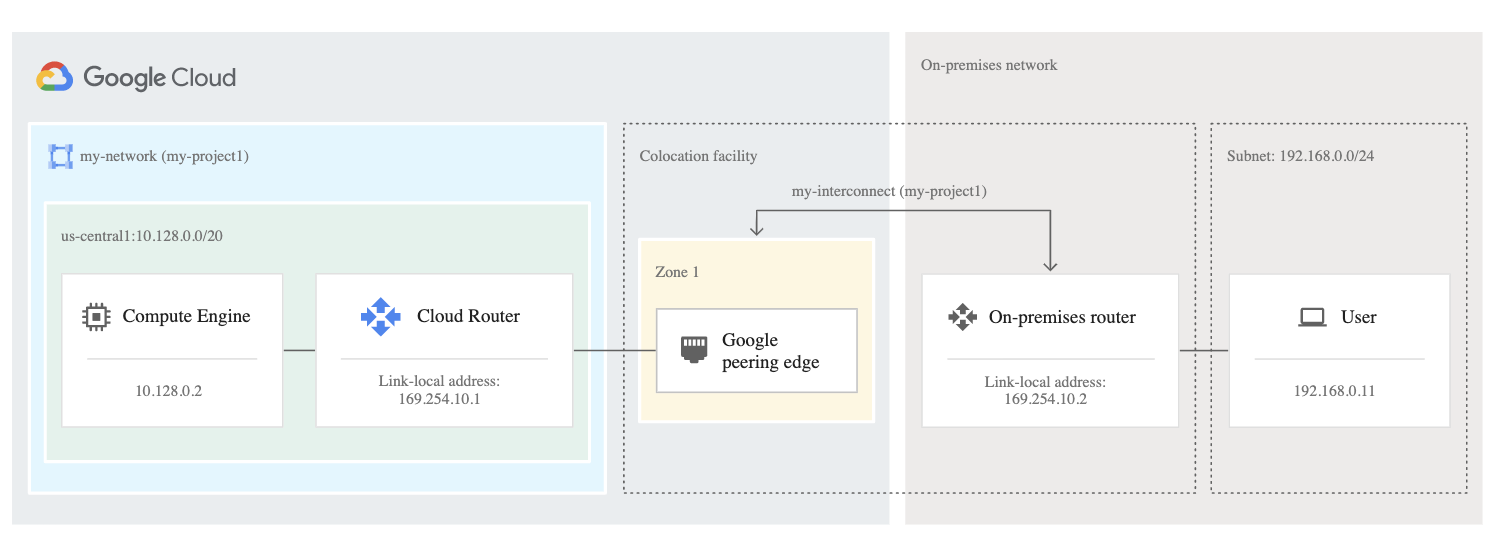
Dedicated Interconnect Provisioning
- Find a collocation facility with GCP Point of Presence (PoP) which offers Direct Interconnect connections
- Order an Interconnect connection so that Google can allocate the necessary resources and send a Letter of Authorization and Connecting Facility Assignment (LOA-CFA).
- LOA-CFA is sent via email to NOC (technical contact) or can be download from the Google Cloud console.
- Submit the LOA-CFA to the vendor so that they can provision the Interconnect connections between Google’s network and your network.
- Configure and test the connections with Google before you can use them.
- Create VLAN attachments to allocate a VLAN on the connection.
- Configure the on-premises router to establish a BGP session with the Cloud Router
Dedicated Interconnect Redundancy
- Single Dedicated Interconnect connection does not offer redundancy or high availability
- Google recommends redundancy using 2 (99.9%) or 4 (99.99%) interconnect connections so that if one connection fails, the other connection can continue to serve traffic
- Redundant Interconnect connection with 2 connections must be created in the same metropolitan area (city) as the existing one, but in a different edge availability domain (metro availability zone).
- Redundant Interconnect connection with 4 connections must be created with 2 connections in two different metropolitan areas (city), and each connection in a different edge availability domain (metro availability zone)
- Dynamic routing mode for the VPC network must be global so that Cloud Router can advertise all subnets and propagate learned routes to all subnets regardless of the subnet’s region.
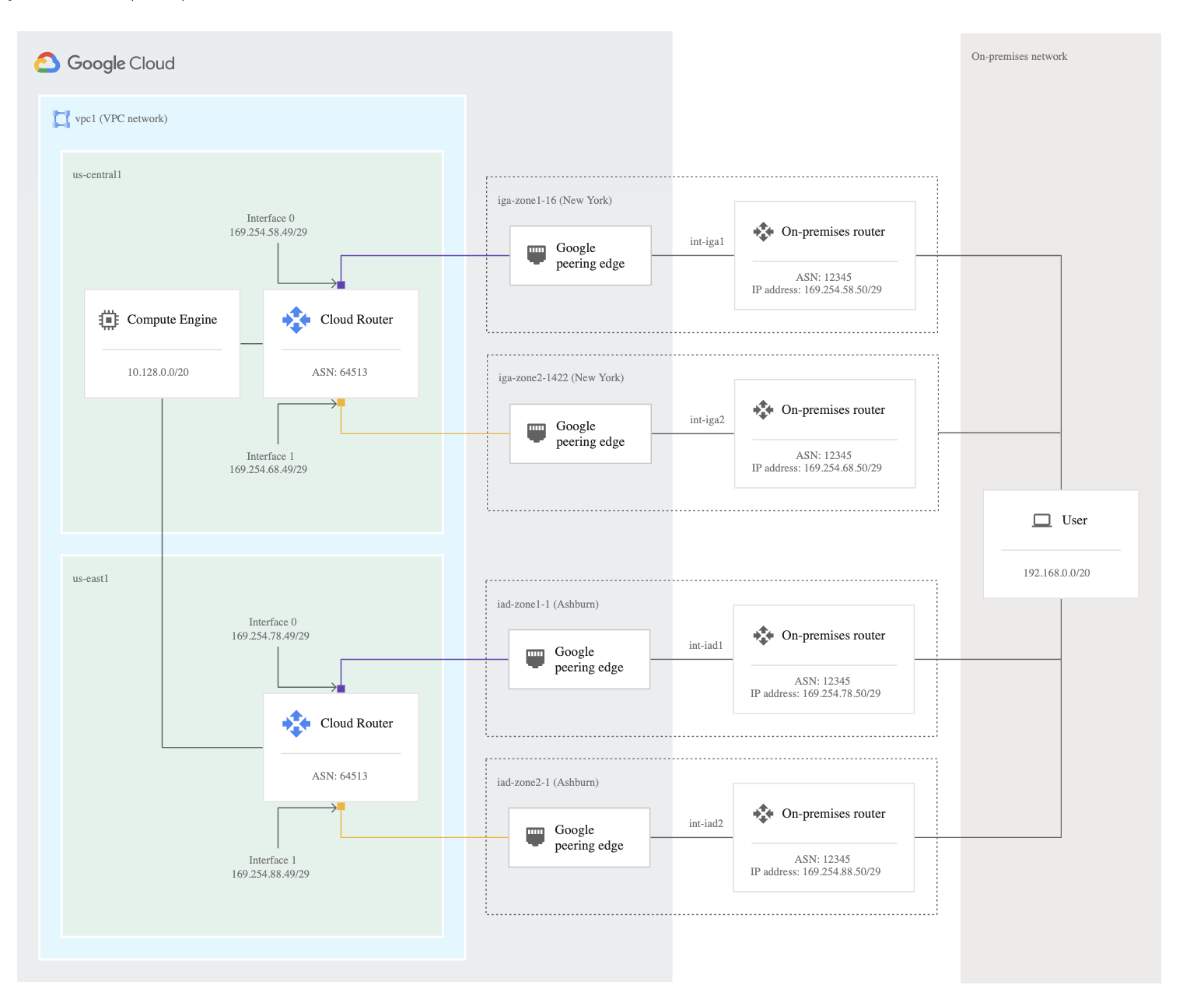
Partner Interconnect
- Partner Interconnect provides connectivity between the on-premises network and the VPC network through a supported service provider
- A Partner Interconnect connection is useful if the data center is in a physical location that can’t reach a Dedicated Interconnect colocation facility, or the data needs don’t warrant an entire 10-Gbps connection.
- Partner Interconnect supports bandwidth to 50 Mbps minimum to 10 Gbps maximum.
- Service providers have existing physical connections to Google’s network that they make available for their customers to use.
- After the connectivity with a service provider is established, a Partner Interconnect connection from the service provider can be requested.
- After the service provider provisions the connection, you can start passing traffic between your networks by using the service provider’s network.
- Partner Interconnect provides Layer 2 and Layer 3 connectivity
- For Layer 2 connections
- you must configure and establish a BGP session between the Cloud Routers and on-premises routers for each created VLAN attachment
- BGP configuration information is provided by the VLAN attachment after your service provider has configured it.
- For Layer 3 connections
- The service provider establishes a BGP session between the Cloud Routers and their edge routers for each VLAN attachment.
- You don’t need to configure BGP on the on-premises router. Google and the service provider automatically set the correct configuration
- For Layer 2 connections
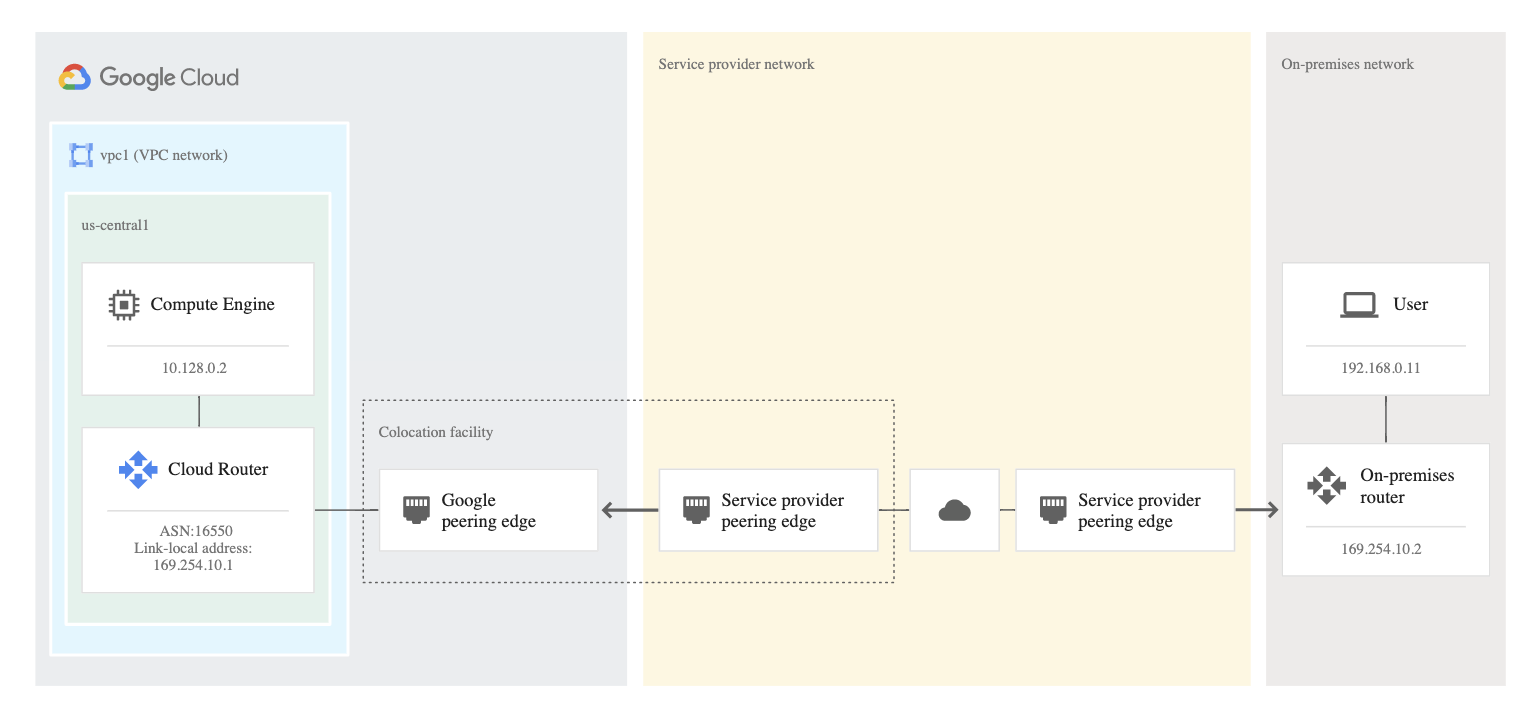
Partner Interconnect Provisioning
- Connect the on-premises network to a supported service provider.
- Create a VLAN attachment for a Partner Interconnect connection in the Google Cloud project, which generates a unique pairing key that must be used to request a connection from the service provider.
- Activate the connection
- Depending on the connection, either you or your service provider then establishes a Border Gateway Protocol (BGP) session.
- Partner Interconnect provisioning does not require LOA-CFA
Partner Interconnect Redundancy
- Single Partner Interconnect connection does not offer redundancy or high availability
- 99.9% availability requires
- At least two VLAN attachments in a single Google Cloud region, in separate edge availability domains (metro availability zones).
- At least one Cloud Router, connected to both VLAN attachments.
- 99.99% availability requires
- At least four VLAN attachments across two metros, one in each edge availability domain (metro availability zone)
- Two Cloud Routers (one in each Google Cloud region of a VPC network).
- Associate one Cloud Router with each pair of VLAN attachments.
- Dynamic routing mode for the VPC network must be global so that Cloud Router can advertise all subnets and propagate learned routes to all subnets regardless of the subnet’s region.
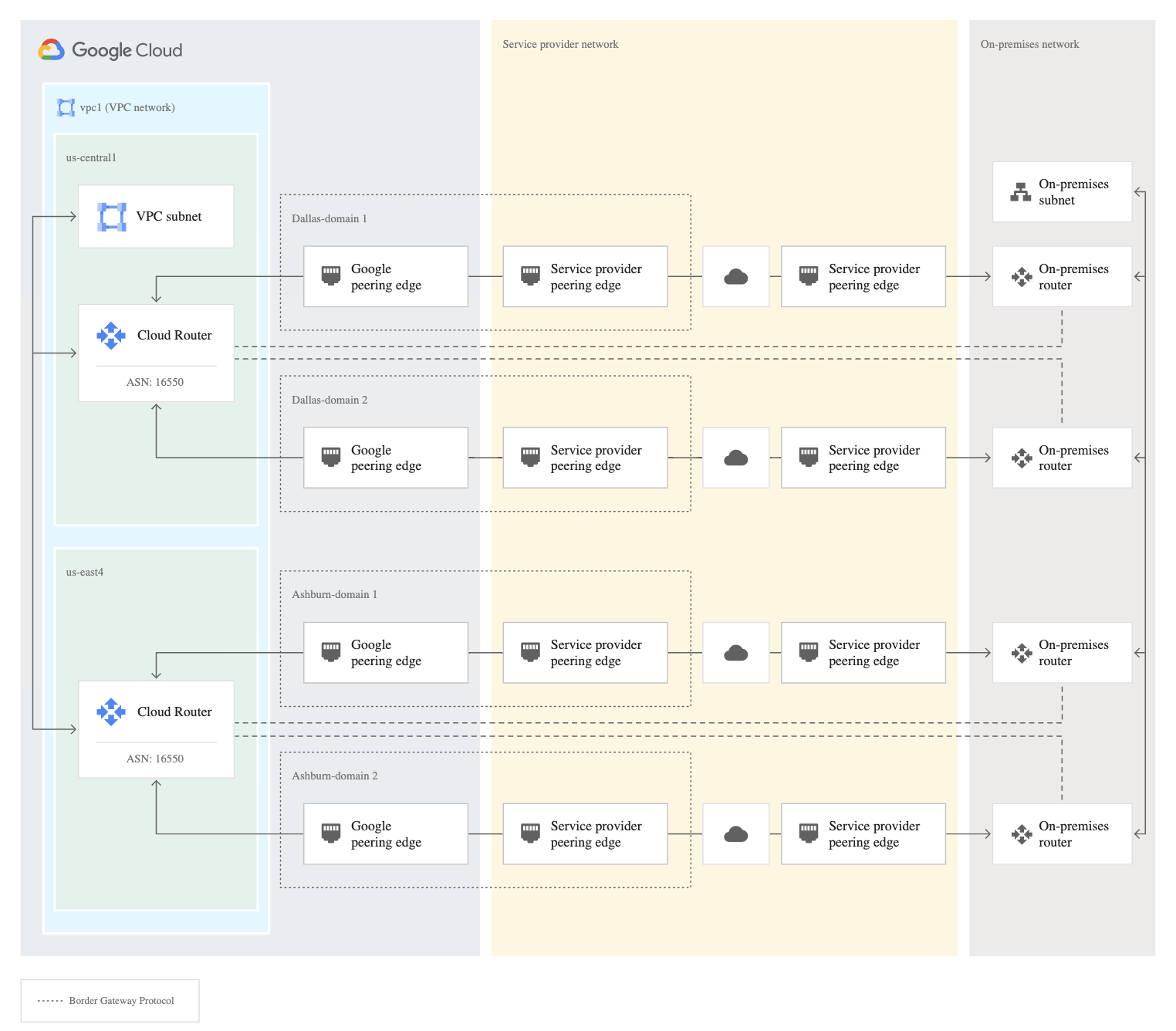
Cloud Interconnect Security
- Cloud Interconnect does not encrypt the connection between your network and Google’s network.
- Currently, Cloud VPN can’t be used with Dedicated Interconnect.
- For additional security, use application-level encryption or your own VPN.
Dedicated Interconnect vs Partner Interconnect
- Choosing between Dedicate Interconnect vs Partner Interconnect, consider the connection requirements, such as the connection location and capacity.
- If you can’t physically meet Google’s network in a colocation facility to reach your VPC networks, you can use Partner Interconnect to connect to service providers that connect directly to Google:
- If you have high bandwidth needs, Dedicated Interconnect can be a cost-effective solution.
- If you require a lower bandwidth solution, Dedicated Interconnect and Partner Interconnect provide capacity options starting at 50 Mbps.
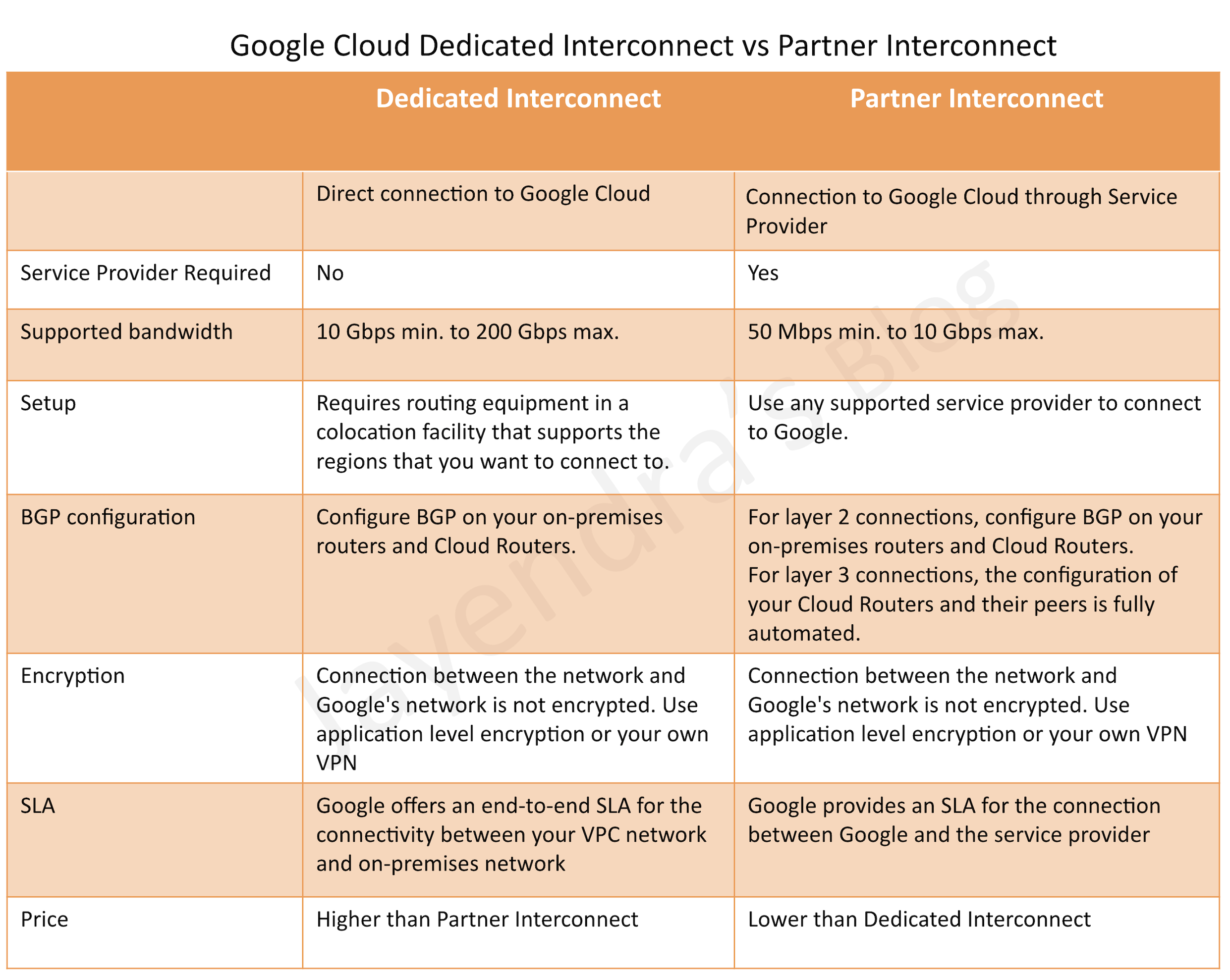
GCP Certification Exam Practice Questions
- Questions are collected from Internet and the answers are marked as per my knowledge and understanding (which might differ with yours).
- GCP services are updated everyday and both the answers and questions might be outdated soon, so research accordingly.
- GCP exam questions are not updated to keep up the pace with GCP updates, so even if the underlying feature has changed the question might not be updated
- Open to further feedback, discussion and correction.
- Your company has decided to build a backup replica of their on-premises user authentication PostgreSQL database on Google
Cloud Platform. The database is 4 TB, and large updates are frequent. Replication requires private address space communication.
Which networking approach should you use?- Google Cloud Dedicated Interconnect
- Google Cloud VPN connected to the data center network
- A NAT and TLS translation gateway installed on-premises
- A Google Compute Engine instance with a VPN server installed connected to the data center network
- A company wants to connect cloud applications to an Oracle database in its data center. Requirements are a maximum of 20 Gbps
of data and a Service Level Agreement (SLA) of 99%. Which option best suits the requirements?- Implement a high-throughput Cloud VPN connection
- Cloud Router with VPN
- Dedicated Interconnect
- Partner Interconnect
- A company wants to connect cloud applications to an Oracle database in its data center. Requirements are a maximum of 9 Gbps
of data and a Service Level Agreement (SLA) of 99%. Which option best suits the requirements?- Implement a high-throughput Cloud VPN connection
- Cloud Router with VPN
- Dedicated Interconnect
- Partner Interconnect